- Culture
- SEE MORE
- classical
- general
- talk
- News
- Family
- Bürgerfunk
- pop
- Islam
- soul
- jazz
- Comedy
- humor
- wissenschaft
- opera
- baroque
- gesellschaft
- theater
- Local
- alternative
- electro
- rock
- rap
- lifestyle
- Music
- como
- RNE
- ballads
- greek
- Buddhism
- deportes
- christian
- Technology
- piano
- djs
- Dance
- dutch
- flamenco
- social
- hope
- christian rock
- academia
- afrique
- Business
- musique
- ελληνική-μουσική
- religion
- World radio
- Zarzuela
- travel
- World
- NFL
- media
- Art
- public
- Sports
- Gospel
- st.
- baptist
- Leisure
- Kids & Family
- musical
- club
- Health & Fitness
- True Crime
- Fiction
- children
- Society & Culture
- TV & Film
- gold
- kunst
- música
- gay
- Natural
- a
- francais
- bach
- economics
- kultur
- evangelical
- tech
- Opinion
- Government
- gaming
- College
- technik
- History
- Jesus
- Health
- movies
- radio
- services
- Church
- podcast
- Education
- international
- Transportation
- Other
- kids
- podcasts
- philadelphia
- Noticias
- love
- sport
- Salud
- film
- and
- 4chan
- Disco
- Stories
- fashion
- Arts
- interviews
- hardstyle
- entertainment
- humour
- medieval
- literature
- alma
- Cultura
- video
- TV
- Science
- en
032: Traditional Italian Food what NOT to do when it comes to Italian food in Italy

b'
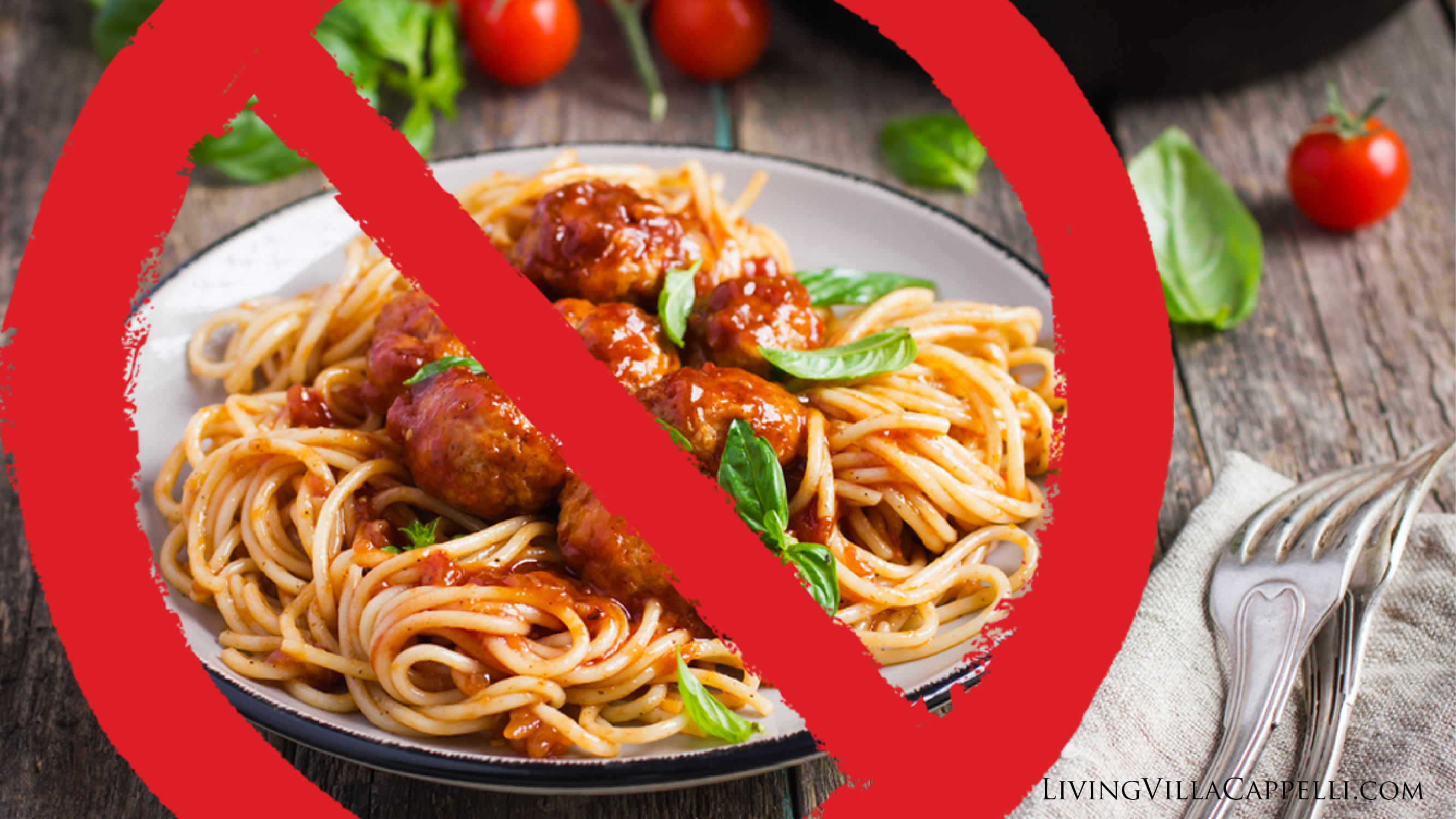
There are lots of "rules" when it comes to traditional Italian food. And what you may think would be the same for Italian food in the states can be very different than what you\'ll find in Italy. Here are 14 things to never do when cooking or eating in Italy.
\\nNote: We base our conversation a lot off this original blog post: http://www.retale.com/blog/culinary-sins-according-proper-italian-chefs/
\\nTopics we cover:
\\n- \\n
- First, our new sponsor Audible.com. Sign up and get a free book AND a free 30 day trial membership. Just go to www.audiletrial.com/cappelli \\n
- The differences between jams and conserves \\n
- And more on Colpo D\'Aria (where I talked about it in this episode):\\xa0 http://www.livingvillacappelli.com/030-italian-cures-for-the-common-cold-fact-v-fiction/ \\n
\\xa0
\\nNow, the all important "don\'ts" when it comes to traditional Italian food in Italy.
\\n1. Don\'t add oil to pasta water
\\nPaul and I agree with this one. It\'s totally not necessary. While your pasta should have salt to flavor the pasta, the oil doesn\'t serve any purpose while you\'re boiling it. It will help as a sauce afterward, and maybe slightly as a non-sticking agent, though you should be tossing your pasta with your sauce right away after removing from your boiling water.
\\nStir your pasta occasionally while it\'s cooking and your should be OK.\\xa0 Be sure to stir spaghetti and other fine pasta right away when adding to your water to keep it from forming a large spaghetti log.
\\nAnd have plenty of water in the pot so the pasta can move around.
\\nPaul believes you should add the salt after the water has come to a boil. Steven doesn\'t necessarily agree. Find out why.
\\n2. Don\'t ever mix cheese and seafood
\\nThis is another one right on the money, except for a key recipe shown below. Never ever add grated cheese to a seafood pasta dish. The restaurant will give you grated cheese if you ask for it, but they\'ll look at you as barbarian tourist.
\\nThe one except I point out for this is Mussels Genovese. Recipe below. NOTE: This is the name the people here in our region of Puglia call this recipe.\\xa0 I\'m sure every region is different.
\\nEssentially, as Paul points out, this is like making a frittata, however it\'s still breaking the rule.
\\n- \\n
- 2 lbs. of mussels, halved \\n
- 6 Eggs \\n
- 2 Tablespoons grated cheese \\n
- 2 Tablespoons chopped parsley \\n
- Pepper \\n
- \\n
- Place the mussels (you only need the half with the actual mussel in it) in a flat bottomed frying pan so the mussels are facing up. Add a bit of water to the bottom of the pan and bring to a boil, then reduce to a simmer. Cover and let cook about 5 minutes. \\n
- Meanwhile mix your eggs, cheese and parsley in a bowl. Add pepper to taste, but don\'t add an salt. The cheese and mussels will have enough. When the mussels are ready, pour the eggs over them in the pan, recover, and let cook until the eggs are cooked, about 4-5 minutes. \\n
- Here is where you would need to used your judgement. You want a thin coasting of the eggs on top of the mussels, but not so much egg that they are completely submerged in a big egg frittata. If you need more, add some more eggs and cheese. And hold back if it looks like you have too much. Use the leftovers for an omelet the next day. \\n
- Serve and enjoy. \\n
A lot of adding the cheese to a pasta is a habit we\'ve all formed, just wanting to add cheese to pasta before we\'ve even tasted it. However, in this case, the cheese just overpowers the flavor of most delicate seafood and Paul says it\'s just not "kosher."
\\nThere are other exceptions here, but as Paul points out, they really aren\'t Italian dishes. Do you know an exception we missed? Let us know in the comments!
\\n3. Don\'t top pasta with chicken
\\n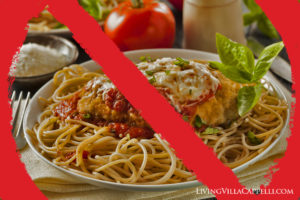 This one\'s totally right. Those dishes you see being passed off as Italian at the big Italian restaurant chain, well, they aren\'t very Italian.
This one\'s totally right. Those dishes you see being passed off as Italian at the big Italian restaurant chain, well, they aren\'t very Italian.
We couldn\'t think of a single pasta dish that even includes chicken. In fact, Italians aren\'t really big on chicken in general.
\\nAnd, by the way, there is no such thing as Chicken Parmesan or Chicken Parmigiana here. It doesn\'t exist.
\\n4. Don\'t serve bread and butter
\\n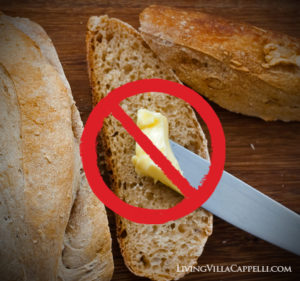 Very very true. They may cook with butter up north, but they really don\'t do the bread and butter thing.
Very very true. They may cook with butter up north, but they really don\'t do the bread and butter thing.
Bread is set at the table so you have it to act as a scarpetta \\u2014 the little shoe \\u2014 to scoop or mop up any remains on your plate. So don\'t go eating all the bread before your meal is even served!
\\nAlso, as we\'ve said before, there is no dipping your bread in extra virgin olive oil here. Just wait until you get home and enjoy some of our oil with some good crusty bread.
\\n5. Don\'t order \\u2018Spaghetti Bolognese\\u2019 or \\u2018Fettuccine Alfredo\\u2019
\\nWell, you might find them in touristy locations, like Rome and Milan, who make Italian American dishes for the tourist, but they aren\'t traditional Italian food.
\\nTo be honest, I did not know this about Spaghetti Bolognese. And, maybe I\'m still too American, but I see no problem with it. There are certain pastas that do go with certain sauces, as they help carry the sauce better, but in this case I think you are OK.
\\nTraditionally, the blogger said tagliatelle is served with the Bolognese, but I\'ve always done rigatoni (https://en.wikipedia.org/wiki/Rigatoni). I like how the thick meaty sauce can get trapped more inside the pasta.
\\nAnd we agree that Fettuccine Alfredo, the most famous \\u201cItalian\\u201d dish in the U.S., is pretty much unknown in Italy.\\xa0 In the words of Madeline Kahn, "It\'s trew. It\'s trew."
\\n6. Don\'t ever order or eat spaghetti with meatballs
\\n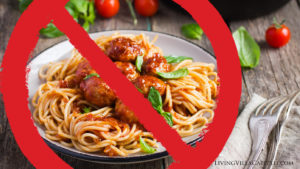 This combination just does not exist in Italian cuisine in Italy.
This combination just does not exist in Italian cuisine in Italy.
Meatballs can be found in a pasta forno or a ragu, but it\'s not something you serve with spaghetti. Ever.
\\nOh, and here we mention Paul\'s Mother\'s Ragu recipe. You\'ll find that here: http://www.livingvillacappelli.com/connie-cappellis-ragu/
\\n7. Don\'t put ketchup on pasta. Never. Ever.
\\nThis one happened to us when we had some Swedes visit. I still can\'t believe it happened.
\\nWho does this? If YOU do, leave us a comment below, but beware our wrath!
\\nOh, and here\'s a link to our Sun-Dried Tomato Spread we talk about: http://villacappelli.com/collections/antipasta-aka-appetizers-1/products/sun-dried-tomato-spread
\\n8. Don\'t treat pasta as a side dish
\\nPasta is a primi (first course after anti-pasti) or MAYBE a main dish, but it is never, ever just a side dish.
\\nThat big ol\' Italian food chain restaurant in the states serves pasta as a side dish if you order something other than a pasta as your main course.\\xa0 At least it used to. I haven\'t been there is over 20 years.
\\nPaul also talks here about how we eat things separately here in Italy. You usually have only one part of your meal on your plate at a time.
\\nI grew up never letting any food on my plate touch each other and only ate one thing at time.\\xa0 So I\'d eat my meat, then my green beans, then my mashed potatoes. And they could not touch!\\xa0 Maybe I really am Italian.
\\nPaul also talks about other guests we had that mixed their salad with pasta. Enough said on that.
\\n9. Don\'t consume a cappuccino at any time except for breakfast
\\nWe\'ve talked about this many times before. Italians just think the milk is too heavy to have after a meal. It won\'t aid in your digestions.
Now, for breakfast, it\'s a whole meal in itself. Especially up north.
\\n10. Don\'t ever disrespect tradition
\\n"Nonna knows best. She learned the recipes from her nonna, who learned from her nonna, who learned from her nonna and so on and so forth."
\\nThis might as well be written in stone.
\\n11. Don\'t use true balsamic vinegar on your salads
\\nWe talked about this more in depth in that last episode: http://www.livingvillacappelli.com/031-why-your-italian-food-is-probably-not-real-food/
\\nAlso, check out our balsamic here: http://villacappelli.com/collections/italian-conserves/products/5-year-aged-balsamic-vinegar
\\n12. Don\'t make or eat thick crust pizza
\\nThick crust pizza is really more a focaccia.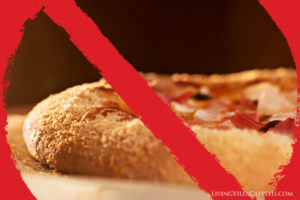
Here, the pizza is more marriage of the thin dough, tomato sauce, cheese and toppings. It\'s not all about the bread. And you can really taste every ingredient.
\\nMost of the pizzas in the states are there to fill you up with a bunch of bread, as it\'s cheaper than the toppings.
\\nHere\'s our pizza crust recipe.\\xa0 Try it and discover the difference.
\\n- \\n
- 3/4 Cup Warm Water \\n
- 1 teaspoon yeast (or one packet of 7g quick rising yeast) \\n
- 2 Cups Flour \\n
- 1/2 teaspoon salt \\n
- \\n
- Mix the warm water and yeast in a bowl. Let sit for a few minutes. Then add your flour and salt to the bowl. Mix until comes together and is forming a ball. \\n
- Turn the dough onto a well floured surface. Wood is best. Just not something cold, like a cold marble counter. \\n
- Kneed the dough for roughly 3-5 minutes until it very elastic and springy. Add more flour or water during this time if need be. But you rarely need more water. If it seems dry, just keep mixing. It will eventually come together. \\n
- Turn the bowl over on the dough and let rise for 1.5 hours. \\n
- Break into four equal parts and roll into smaller balls. Let these rise another hour under and warm dish towel or the like. \\n
- When ready, roll into a very thin crust, about a 1/4 inch thick and about 8 to 9 inches in diameter. Top lightly with sauce, cheese and toppings. Do NOT add too many toppings or the crust won\'t be able to hold it when you are eating. \\n
- Cook in an extremely hot oven. At least 500\\xb0F or more. For our wood-burning pizza oven, this cooks in about 3 minutes. For home ovens, it will probably take you 5 to 10 minutes. \\n
- To bake your pizza, slide it on top of a baking stone or upside-down sheet pan. Bake until the cheese is melted, the crust is golden, and there is some charred bits on the top and edges. \\n
13. Don\'t eat your salad BEFORE a meal
\\n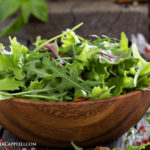 The salad, and the roughage you find in the salad, helps you digest after a big meal.
The salad, and the roughage you find in the salad, helps you digest after a big meal.
It\'s all about digestion in Italy, and this is no exception. You won\'t even find many places that will give you a side salad during your meal.
\\n\\xa0
\\n14. Don\'t put any dressing on your salad other than extra virgin olive oil and vinegar
\\nRanch. Thousand Island. French. You just can\'t find it here.
\\nThis probably goes back to the fact that you are eating the salad at the end of the meal. To add a bunch of heavy dairy or sugar after eating a big meal would just fill you up., where as the vinegar almost acts as a pallet cleanser.
\\nWhat do you think? Did we miss a don\'t when it comes to traditional Italian food? Let us know in the comments or leave us a voice mail.
\\n\\xa0
'